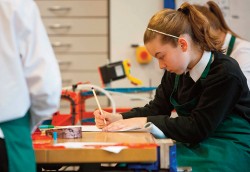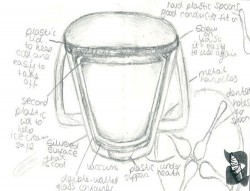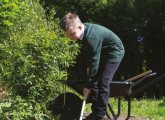Fast food is so familiar to young people and is one thing that can provide a real-world example of where design really matters. Helping students understand the science behind the industry, then turning this into an activity for a specific purpose will keep their interest high and should produce some quality results and good understanding.
The best science teaching involves applying theory. A belief in learning by doing, and recognising that the role of scientist is to produce tested knowledge and the role of the designer is to transform this into a product, gets the best out of students, and for both subjects.
This D&T lesson should be taught in conjunction with a science activity looking at suitable materials for keeping fast food close to its original temperature. Students can consider fast food packaging they are already familiar with, and predict and test which will work best keeping certain foods (e.g. potatoes) hot or cold.
Once they have an understanding of which materials work best, and have been set up to consider the task, you can introduce an activity in which they learn about how a vacuum flask works, analyse some products and apply this to a task in which they design a container suitable for holding, transporting and advertising ice cream.
Today you will…
• Start to understand how a vacuum flask functions, and use this knowledge in a design task to improve other products
• Discover three methods of heat transfer, and state one way a vacuum flask prevents heat transfer
• Explain how vacuum flasks prevent heat transfer design a new product and explain how it fits the brief.

Starter activity
Hot and Cold
Display the image of a hot drink and a cold drink in the same room as students enter the class.
Think, Pair, Share
Ask students to think about the answers to these questions, pair up to see if they can add more to their answers, and then share to the class promoting a longer discussion. Encourage answers involving heat transfer by asking:
What is happening?
What will happen over time? Why does a cold drink get warm and a warm drink go cold?
You could also have actual hot and cold drinks and measure the temperature during the starter activity, remeasuring at the end of the lesson to see the changes.
Heat Transfer Theory
Recap what students have already learnt in science about heat transfer: conduction, convection and radiation, and be able to relate this to ideas about particles.
Main activities
1. Product analysis
Start a discussion about why designers analyse existing products and what we can learn from doing so. Before students take a user trip, they need to understand more about how a product works and the theory behind it by answering questions that build in difficulty. This activity works well if you can demonstrate how a vacuum flask works through disassembly, using scientific terminology to explain how the flask prevents heat transfer.
2. User trip
Get your students to work in groups to use and analyse some example products (Thermos flasks, vacuum cups etc.) answering questions in detail.
Is it easy to use? Can you open it? How do you drink the liquid inside? What is its main function? What are its secondary functions? Does it fulfil these functions well? Do I like the aesthetics of the product? Discuss colour, shape, texture, etc. Would I want to own it or use it? What situations would it be useful for? What is wrong about the design? They should then use their answers to suggest any improvements that could be made to the flask.

3. Design task
Explain the following scenario: An ice cream shop currently sells its products by the cone, but the owners want to increase their profits by selling larger quantities. You have been asked to design a container that will:
• Keep ice cream cold for up to 12 hours while the customer transports it
• Advertise the company and inform the customer of the flavour
• Contain 1L of ice cream
• Contain four of the company’s promotional spoons that they give away with each ice cream sold.
Once the students are aware of what the product needs to fulfil, it may help to explain to them the order of priority that the statements are in (for example, keeping the ice cream cold is more important than containing the spoons).
Encourage students to fill a section of their workbooks with sketches of their product, but also remind them of the need for notes that explain how they are meeting all of the specification points. Prompts might include: the product needs to prevent heat transfer; what knowledge have we gained that will help us fulfil the product’s purpose? Encourage students to use previous pages of the workbook to aid their annotating.
Thumbs up, thumbs down
Ask students to show their thumbs up, middle or down to display their attitude towards the following statements:
• I enjoyed the Heat Transfer Project
• I understand the methods of heat transfer more than I did before the project
• I understand how scientific knowledge could be used in D&T to help improve products This project has been taught in schools and has shown that it can benefit both staff and students in a number of ways:
• Students making explicit links between their scientific knowledge within their D&T lessons. This should accelerate this sort of ‘joined up’ approach to learning.
• Students have the opportunity of using data logging technology to carry out their investigations. They often find the use of this ‘high tech’ equipment really motivating. Staff will find this beneficial because it allows the development of a greater understanding of the curriculum and the pedagogy of another subject. This deepened knowledge can only benefit students when we make these links explicit in subsequent lessons.
It also helps improve students’ perceptions of teachers who are often only seen around their department in the school; when taught, many were impressed with teachers’ knowledge of each other’s subjects.
Summary
Students can peer assess each other’s work by writing statements at the bottom of the page – two stars (things their peer has done well) and one wish (a thing their peer could improve next time).
Info bar
This activity was originally developed by Fabia Hully and Steven Cartwright from Trentham High School specialist science college and we are grateful for their help with this.
Additional resources
• A full set of lesson plans, teacher notes, an introductory powerpoint and student workbook are available for D&T association members to download from the association website data.org.uk
• With a wealth of experience spanning 25 years, technology supplies ltd has built an outstanding international reputation for supplying quality, innovative, exciting and affordable design and technology products. For more information call 0845 567 0000, or visit technologysupplies.co.uk
About the expert
Andy Mitchell is the assistant chief executive at the Design and Technology Association. The Association provides support, advice and subject leadership for all those involved in D&T education (data.org.uk)









